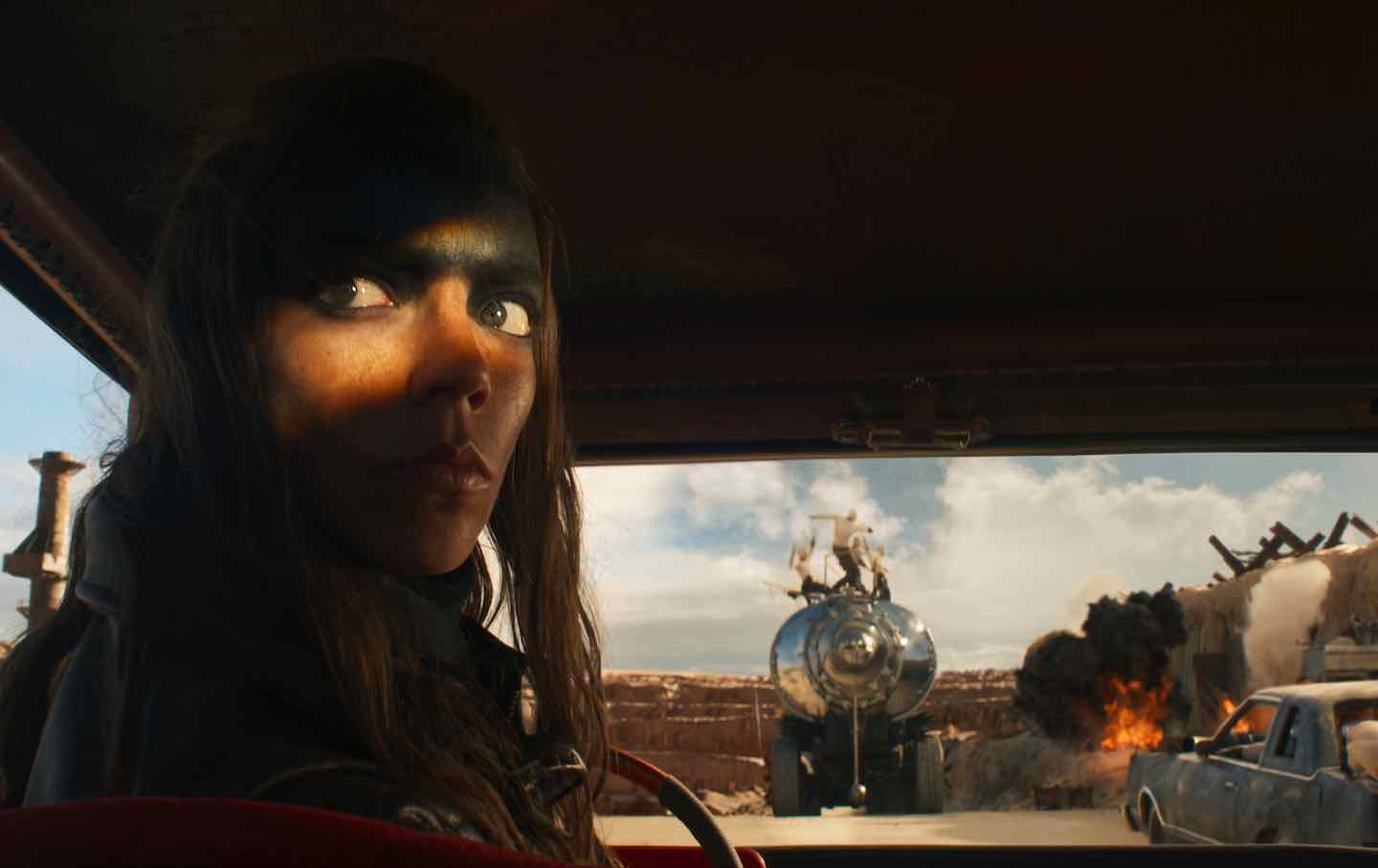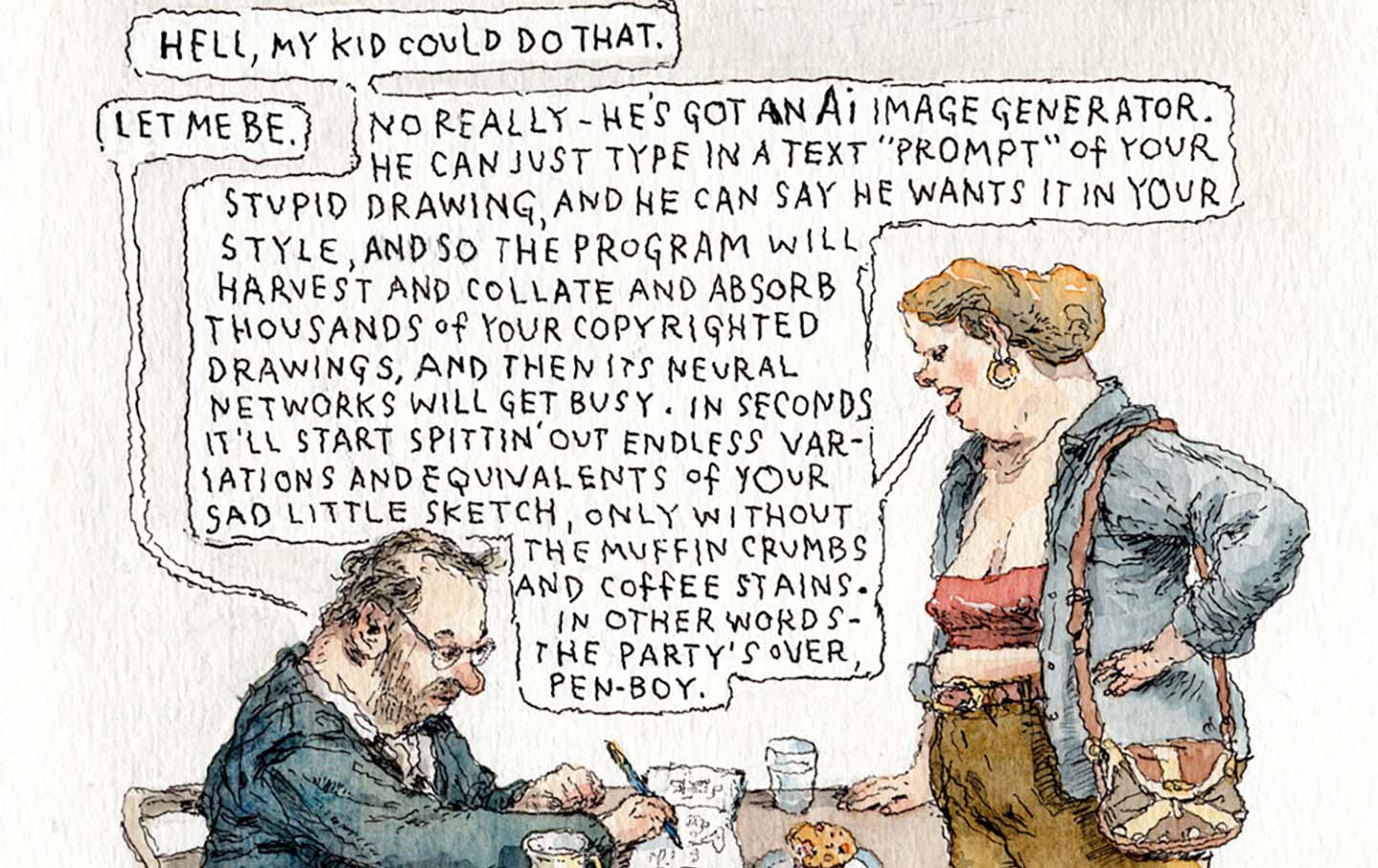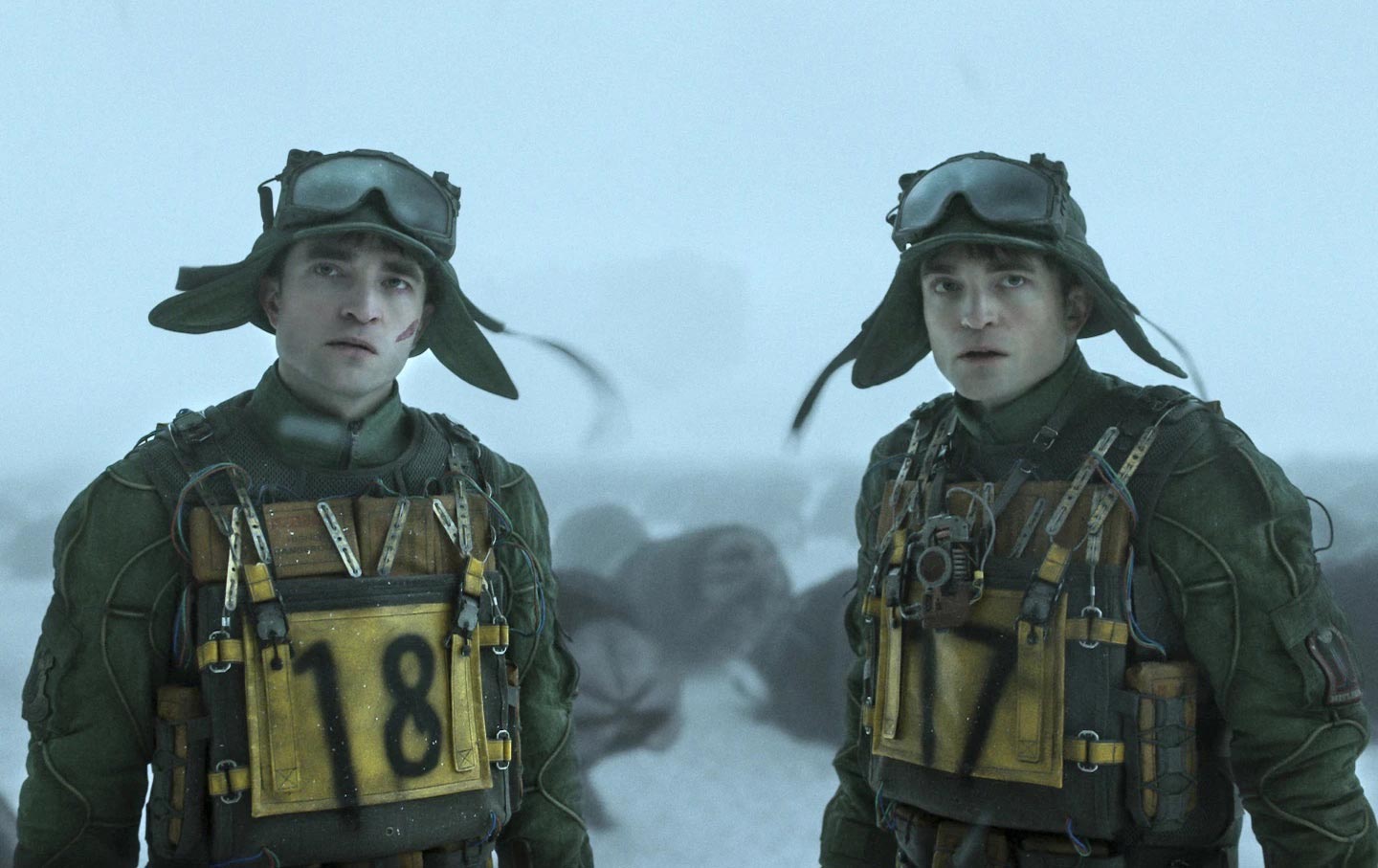Why Did “Furiosa” Flop?
A web of interconnected reasons might explain why George Miller’s long-awaited new entry to his Mad Max series failed in the box office.

Anya Taylor-Joy in
(Courtesy of Warner Bros. Pictures)
George Miller’s long-in-development Furiosa boasts an all-too-familiar narrative: an expensive labor of love struggling to make a commercial impact in an increasingly narrow entertainment landscape. The fifth entry in Miller’s Mad Max series, and a prequel to the acclaimed Mad Max: Fury Road (2015), Furiosa opened to a disappointing box-office gross this past Memorial Day weekend, just barely beating out The Garfield Movie, and its return has precipitously dropped with each successive week. Though roughly half of Furiosa’s budget was subsidized by the Australian government, which makes the film’s break-even point lower than usual for a blockbuster of this scale, it’s clear that Miller’s latest picture has fallen below forecasted projections, even if it eventually turns a profit.
Furiosa’s disappointing commercial performance cannot be distilled into a single explanation; a web of interconnected reasons are all to some degree responsible. The film was pre-scheduled to surrender its premium large-format screens, where it performed the best and whose higher ticket price was essential to its domestic gross, to Bad Boys: Ride or Die in its third week in theaters. The Mad Max series likely doesn’t have the same brand recognition as other intellectual properties, especially considering that Max himself isn’t even prominently featured in Furiosa. (Though it didn’t flop, Fury Road wasn’t a huge hit either.) Theatrical ticket sales have diminished across the board for a variety of reasons—the proliferation of streaming and VOD services, as well as the long-tail effects of the pandemic and the WGA/SAG strikes, which have impacted moviegoing and the release calendar, respectively—and Memorial Day weekend 2024 had the lowest total box-office receipts since 1995. Miller’s film—a brutal, shambolic, postapocalyptic character study—was poorly suited to thrive in this new state of affairs, but one can hardly blame the director and his ambition for all that ails Hollywood.
With Furiosa, Miller has invested more in immersing audiences in the bleakness of his world than in raising their pulse, an admirable tonal pivot that also probably didn’t help the film’s commercial prospects. Though it contains scenes of vehicular mayhem and righteous bloodshed, its sensibility is a far cry from the high-octane thrill ride of Fury Road. Novelistic, ambiguous, and uncompromisingly grim, Furiosa resembles a tragic fable about vengeance in a fallen world more than a traditional action movie.
Furiosa’s self-conscious construction primarily extends to its mythic storytelling, complete with chapter breaks and an omniscient narrator, but it also encompasses the lattice of relations that make up the film’s plot. Dementus (Chris Hemsworth), the ostentatious leader of a roving biker gang and the film’s main antagonist, takes a young Furiosa (Alyla Browne) captive, forces her to watch his gang brutally crucify her mother, and then adopts her as his unwilling daughter in the vain hope that she will one day lead him to the oasis-like Green Place where she was raised. Dementus jockeys for power and resources in the radioactive Australian wasteland against the skeleton-masked warlord Immortan Joe (Lachy Hulme), whose entourage of grotesque advisers counsel his rule over the Citadel and supply negotiations with the allied oil refinery, Gas Town, and Bullet Farm, a mining facility.
Meanwhile, Furiosa desperately tries to return home without giving up the location of her matriarchal Eden to various marauders. Initially seen as a spry young girl trying to pick fruit from a tree, she becomes a haggard prisoner under Dementus’s thumb after her proverbial fall from grace. When he trades her to Immortan Joe after he invades Gas Town, Furiosa quickly disguises herself as a mute boy to escape the brood-sow-like fate of becoming one of the Imperator’s wives. As she ages into a young adult (played now by Anya Taylor-Joy), Furiosa ingratiates herself among Joe’s men for years and becomes an expert mechanic; her quick thinking and resolute attitude impresses Joe’s top driver, Praetorian Jack (Tom Burke), who mentors her and wishes to aid her escape.
Because it’s a prequel, we know Furiosa will become the tenacious, shaven-headed warrior that Charlize Theron portrayed in Fury Road. We also know that she never returns to the Green Place, and that both Dementus and Praetorian Jack are not long for this world. To combat this absence of surprise, Miller imbues appropriately somber emotion into Furiosa’s journey. But as the character traverses miles of desert across multiple decades, fighting for survival within many environments like the hero of an 18th-century picaresque, a crucial dynamism frequently becomes lost in the process. Furiosa doesn’t aim to inspire awe the same way that Fury Road’s sheer unrelenting action did, but sometimes it inspires only passive appreciation, which makes it more frustrating in light of the film’s occasional flashes of brilliance. Flawed though it may be, Furiosa aspires to a certain fabulist maximalism that the market rarely recognizes, let alone rewards.
Mad Max (1979), Miller’s debut, was based partly on the severe vehicular accidents he witnessed as a child and working as a doctor in Sydney. Coscreenwriter and former journalist James McCausland also channeled the errant rage felt by Australian motorists during the 1973 OPEC embargo into the script. (“A couple of oil strikes that hit many pumps revealed the ferocity with which Australians would defend their right to fill a tank,” he recalled.) This cultural and political context informed the dystopian reality of the series, which initially depicts a society on the precipice of full law-and-order breakdown before transitioning into a hellscape where survival depends on scrounging for scant resources at all costs.
Grief, and specifically the concern for children, animates the series’s hard-won optimism, which stands in sharp contrast to the films’ barren, desolate environments. Mel Gibson’s Max was spurred to be a vengeful wanderer after a biker gang brutally murders his wife and son in Mad Max, and the character subsequently feels an innate desire to save all the innocents he can. In The Road Warrior (1981), the haunted Max protects a mute feral child from vicious gangs, and in Mad Max Beyond Thunderdome (1985), he guides a primitive tribe of lost children descended from the survivors of a long-forgotten plane crash to safety. Fury Road’s Max, now played by Tom Hardy, sees visions of a child that he couldn’t save.
Furiosa’s depiction of a robbed childhood, marked by abduction and murder and the fight for survival, is a logical extension of the series’s focus on protecting the young as a necessity for humanity’s future. Browne’s portrayal of the young Furiosa visually recalls a more tamed version of Road Warrior’s feral counterpart, and it’s easy to slot Taylor-Joy’s older Furiosa into Thunderdome’s band of survivors, yet Miller underscores both the singularity of the character’s solitary, resourceful nature in the face of trauma and its inevitable connection to Max’s origins. Our paths are our own, Furiosa argues, but they exist on a continuum of other experiences from the past, present, and future.
Browne and Taylor-Joy’s performances embody a raw-nerve fury that commands attention, and it’s the latter’s visual rhyming with Theron’s portrayal that lends some poignancy to the character’s hardship and sacrifice. We watch Furiosa witness brutality after brutality, evade sexual assault as a child, experience dismemberment and torture as a young adult, and ultimately achieve the kind of retribution that isn’t designed to rouse crowds.
“It’s mind-numbing that Furiosa hasn’t grossed $50 million domestically,” an anonymous studio exec told Deadline at the beginning of June. Given the film’s substance, not to mention its grim tone and measured pace, it’s staggering that it made that much at all. But as much as Miller strives to bestow his character’s heroic tale with the patina of a dark oral legend, the film’s epic heft not only highlights the weightlessness of some key sequences (like many of the early Dementus scenes), but also its obsession with its own mythos, which can feel a little too insistent. Miller forces a legendary polish as if it’s the same as simply exhibiting it.
The Mad Max series’s loose connective tissue allowed for each entry to have a different aesthetic and narrative identity, but because Furiosa is connected to Fury Road by design, it suffers in its shadow. Miller effectively drops the audience in medias res in Fury Road, and thus the film reduces traditional world-building to throwaway lines and fleeting images. This choice makes the high-wire action feel both primary and organic and allows for the characters’ depth of emotion not to feel overdetermined: Think of how briefly Miller touches on Max’s universal-blood-donor status at the film’s beginning, and how it movingly pays off by the end.
Furiosa switches this calculus, and it becomes in part about needlessly explicating a world that Fury Road had already textured. We actually visit Bullet Farm and Gas Town when initially those were just cheeky locales that resided in the imagination. We discover how Furiosa lost her arm, which Miller commendably tries to infuse with pathos, but it can’t escape the rigid necessity of its inclusion. (Theron reportedly used the script of Furiosa, which Miller had completed over a decade ago, as a reference for her performance in Fury Road, which falls in line with the latter film’s embrace of suggestion over exposition.) On paper, it offers more of “what we want” with relation to what Fury Road introduced, but much of that film’s success was how much it withheld in terms of exposition, and how much it doubled down on pure formal bravado.
It’s predictable, but no less exciting, that Furiosa shines during its vehicular set pieces. Watching Taylor-Joy and Burke team up to fend off an air assault on the War Rig or escape from a Dementus ambush provides a rush that only Miller can engineer. Even as he relies more heavily on “expressionistic” CGI this go-round, Miller films action in an unparalleled kinetic manner, with editors Margaret Sixel and Eliot Knapman seamlessly binding together a network of interlocking skirmishes across multiple bodies until they form a chaotic matrix. As much as Furiosa treats its origin tale like an ancient text, one transmitted from a distant future, it’s at its best when it resembles earlier Mad Max films—the car chases, the heightened tension, and the peril and perpetual motion.
Miller has had experience with expensive fiascos in the past. The commercial failure of Babe: Pig in the City (1998)—the dark, masterful follow-up to the more explicitly family-friendly Babe (1995)—contributed to the dismissal of two high-level executives at Universal. Miller’s Dr. D Studios, a Sydney-based digital animation studio founded in 2007, was shuttered just six years later following the financially unsuccessful sequel to the other IP he’s most famous for, the jukebox musical Happy Feet (2006), in which a tap-dancing emperor penguin struggles to prove his worth to his vocally gifted colony. Miller’s previous film, Three Thousand Years of Longing (2022), grossed only a third of its $60 million production budget, which is somewhat impressive given that it’s a maximalist fantasy romance between a narratologist and a Djinn, based on an A.S. Byatt short story.
Popular
“swipe left below to view more authors”Swipe →It’s vulgar to reduce films to their revenue potential, especially when Furiosa’s box-office struggles embody a dilemma that is at once classic and contemporary. Filmmakers have bemoaned the industry’s fixation on opening-weekend numbers since Jaws and Star Wars permanently reshaped studio marketing. At the same time, a film’s instant financial success in theaters arguably matters more than ever. Furiosa’s failure to garner commercial traction ultimately says more about the context of its release, not to mention the studios’ frustrating commitment to short-term thinking, than the quality of the film itself.
The general defensiveness around Miller and Furiosa from both fans and critics comes from an understandable place, too. His iconoclasm unfortunately requires significant investment at a time when it likely won’t be theatrically supported, and though he’s not alone among his peer group in this regard, it’s remarkable that a nigh-80-year-old man can still mastermind such high-concept, large-scale flights of mayhem and fancy. Gonzo designs and surrogate family dramas have dominated Miller’s entire oeuvre, and he neatly combines these two aspects in Furiosa’s most affecting, casually tossed-off moment: Its title character, sensing impending doom, clutches Jack’s head and privately whispers assurance as garishly costumed biker pirates circle them menacingly.
Still, Furiosa proved to be a mildly vexing viewing experience. Though I admired Miller’s painterly images of intensely color-graded disorder, the fractured narrative and the forced grandiosity kept me at a remove. Appreciation competed with monotony until Furiosa’s final confrontation with Dementus, which is when the film’s emotional and thematic core finally clicked, with just minutes to spare. Hemsworth’s entertaining theatrics immediately give way to nihilistic pain, and Taylor-Joy, who exhibits notable restraint for much of the film, communicates her character’s heartbreak and futile rage in just a few close-ups. As the two meditate on the value of vigilante justice in a world rife with cruelty and bereft of fairness, Furiosa subverts its revenge narrative by planting a literal seed of hope that feels neither contrived nor saccharine. Furiosa could never surpass Fury Road, but its triumphs and frustrations are in service of something grander than most summer blockbusters reach for.








